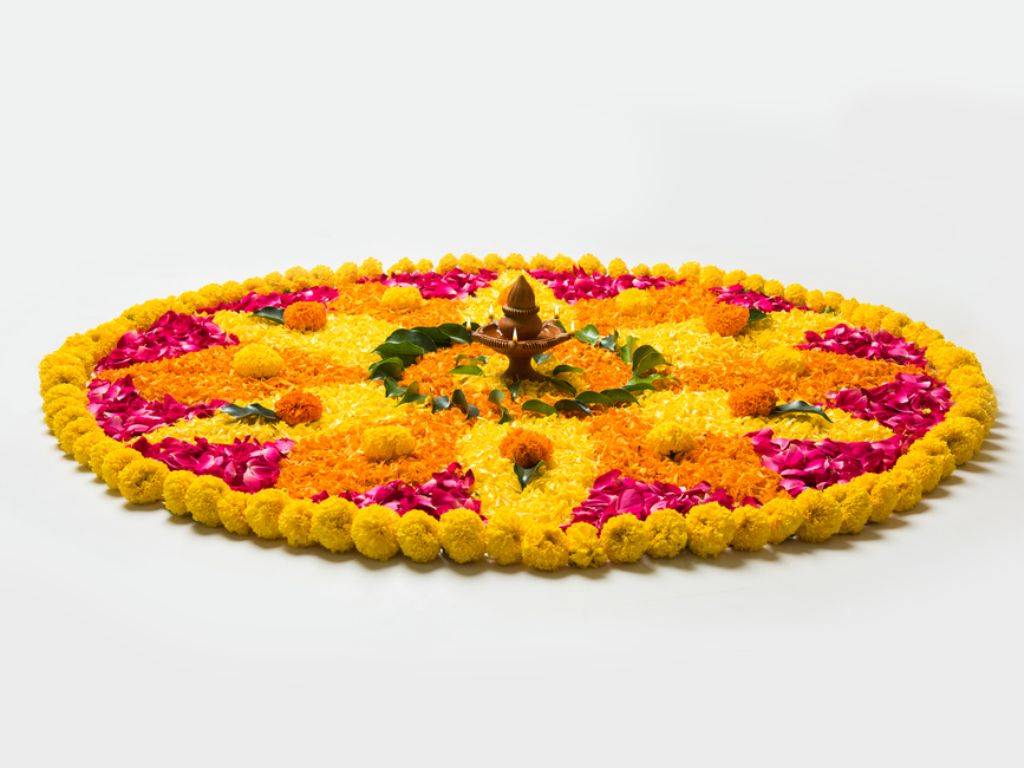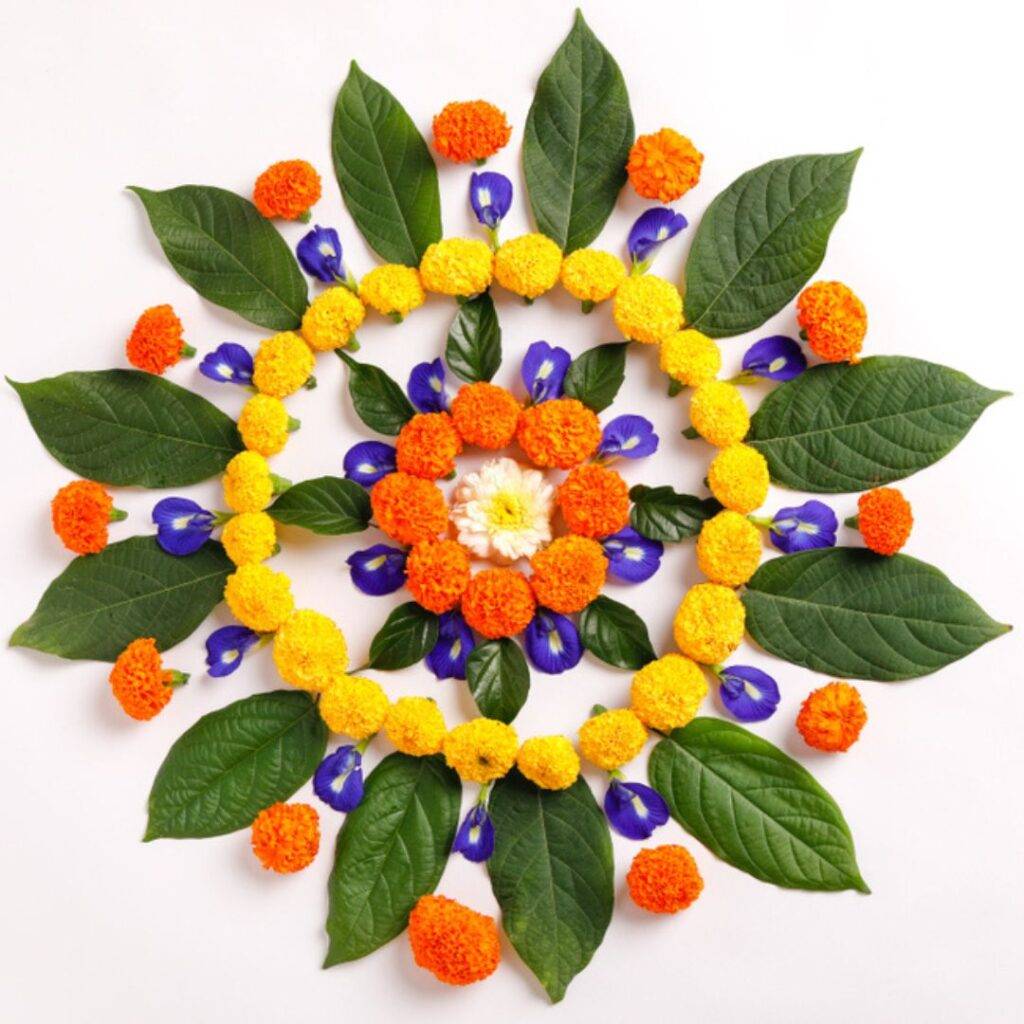Diwali, the festival of lights, is one of the most celebrated festivals in India. Along with diyas (lamps) and sweets, creating colorful rangoli designs is a fun and creative way to decorate homes, schools, and other spaces. However, in recent years, there’s been a growing emphasis on celebrating Diwali in a more environmentally friendly way. Traditional rangoli often involves chemical colors that can harm the environment, but there are many eco-friendly alternatives that are both beautiful and sustainable.
5 Eco-Friendly Rangoli Ideas for School Celebrations
Here are five eco-friendly rangoli ideas for school celebration that are safe, fun, and kind to the environment. If you’re looking to involve kids in making eco-friendly rangoli at school this Diwali.
1. Flower Petal Rangoli
Using fresh or dried flower petals is a wonderful way to create colorful, natural rangoli designs. Flowers like marigolds, roses, chrysanthemums, and jasmine offer a vibrant palette of colors and textures. Plus, they’re biodegradable and don’t leave behind any waste.
Also Read: Latest Eco-Friendly Diwali Activities for the Year 2024
How to do it:
- Start by outlining your design using chalk or white flour on the ground.
- Gather a variety of flower petals in different colors.
- Fill in the design with the petals, arranging them in sections to highlight the colors.
- Use entire flowers or just petals for more detailed work.
Why it’s great for schools:
- Easy for kids to participate in.
- Fresh flowers can be composted after Diwali, reducing waste.
- It teaches students about using natural resources creatively.
2. Grain and Pulses Rangoli
Creating rangoli designs with grains and pulses is a fun way to use kitchen staples like rice, lentils, and beans. These items come in a variety of colors and textures, allowing for intricate and unique patterns.
How to do it:
- Start with a basic outline of your design using chalk or a natural material.
- Use colored rice or grains like yellow lentils, red kidney beans, and green mung beans to fill in different parts of the rangoli.
- For added color, you can soak rice in natural food dyes made from turmeric (yellow), beetroot (pink), or spinach (green) before drying it out and using it.
Why it’s great for schools:
- Grains and pulses are easily accessible and inexpensive.
- This activity can double as a learning experience, teaching kids about food and sustainable living.
- After Diwali, the grains can be safely disposed of or used as bird feed, avoiding waste.
3. Salt Rangoli with Natural Colors
Colored salt rangoli is another eco-friendly option. By using food-based, non-toxic dyes, you can color salt naturally and avoid using harmful chemical powders. It’s a safe option, especially for younger children in schools.
How to do it:
- To color the salt, mix it with natural dyes made from food ingredients like turmeric, spinach juice, or beetroot juice. Let it dry completely before using it.
- Once the salt is colored, create a rangoli design on the floor using chalk or flour.
- Fill in the different sections with colored salt.
Why it’s great for schools:
- Non-toxic and safe for kids to handle.
- The colored salt can be reused for future activities or sprinkled in the garden afterward.
- It’s a great way to introduce kids to natural dyes and sustainable craft practices.
4. Leaf Rangoli
Leaves are an often overlooked yet beautiful material for creating natural rangoli designs. Collecting different shapes and shades of leaves can result in an earthy, vibrant rangoli, perfect for an eco-friendly Diwali.
How to do it:
- Collect leaves from various trees, looking for different sizes and colors (green, yellow, brown).
- Use larger leaves to form the borders or outer designs, and smaller, more delicate leaves to fill in the details.
- You can also layer the leaves to create interesting patterns and textures.
Also Read: Diwali Celebration Ideas for Schools
Why it’s great for schools:
- It encourages kids to connect with nature by collecting leaves themselves.
- Leaves are entirely biodegradable, and after the festival, they can be composted.
- It makes for a unique and refreshing twist on the usual rangoli designs.
5. Rangoli with Chalk and Flour
For a simple, mess-free rangoli option, using white flour, chalk powder, or rice flour to draw intricate patterns on the floor is an effective way to create stunning designs. This method is quick and easy, making it perfect for busy school environments.
How to do it:
- Draw the desired rangoli pattern directly onto the ground using white rice flour or chalk powder.
- You can combine this with colored natural powders or sprinkle turmeric for a pop of color in certain sections.
- Another option is to create patterns on blackboards or whiteboards using colored chalk for a non-permanent rangoli display.
Why it’s great for schools:
- Minimal waste—chalk or flour can easily be washed away without harming the environment.
- It’s easy to clean up after the celebration.
- The process of creating detailed, symmetrical designs with flour or chalk is a good motor skill activity for younger students.
Celebrating Diwali in an eco-friendly way doesn’t mean you have to miss out on the fun of creating beautiful rangoli designs. By using natural, sustainable materials, schools can help teach students the importance of protecting the environment while still enjoying the rich traditions of this festival.
Incorporating eco-friendly practices into Diwali celebrations, especially at a young age, encourages children to adopt sustainable habits in the future. Whether using flowers, grains, leaves, or salt, these creative rangoli ideas can brighten up your school Diwali celebrations without causing harm to the environment.
So, this Diwali, why not give one of these eco-friendly rangoli designs a try? It’s a fun and meaningful way to celebrate the festival of lights while making a positive impact on the planet! However, if you wish to learn more about innovative diwali celebration ideas then you can connect with Dr. Kishore’s Ratnam Schools in Nellore, Kavali, Tirupati & Srikalahasti.
Frequently Asked Questions
Celebrating Diwali eco-friendly reduces environmental impact and teaches children the importance of sustainability. It encourages lifelong habits that contribute to protecting our planet.
Fresh or dried flower petals from marigolds, roses, and jasmine are ideal for colorful and vibrant Rangoli designs. They are biodegradable and can be composted after use.
Yes, using chalk or flour allows for easy and mess-free Rangoli designs. This method is quick, easy to clean up, and a great way to enhance motor skills in young students.




